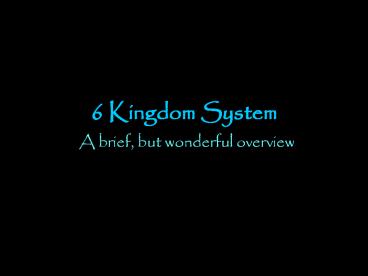6 Kingdom System - PowerPoint PPT Presentation
Title:
6 Kingdom System
Description:
6 Kingdom System A brief, but wonderful overview The Six Kingdoms are Starting with the least complex to the more complicated and fancy.. 1 Archaebacteria 2 ... – PowerPoint PPT presentation
Number of Views:111
Avg rating:3.0/5.0
Title: 6 Kingdom System
1
6 Kingdom System
- A brief, but wonderful overview
2
The Six Kingdoms are
- Starting with the least complex to the more
complicated and fancy.. - 1 Archaebacteria
- 2 Eubacteria
- 3 Protists
- 4 Fungi
- 5 Plants
- 6 - Animalia
3
Kingdom Archaebacteria
- General Characteristics
- 1. Single-celled and Prokaryotic (cells have no
nucleus) - Asexual reproduction
- Come in 3 shapes
- -cocci, rod, spiral
- 4. Live in extreme conditions very salty, hot,
acidic
4
Kingdom Eubacteria
- Single-celled and eukaryotic (cells have a
nucleus) - Asexual reproduction
- 3. Come in 3 shapes cocci, rod, spiral
- 4. Found e Come in 3 shapes cocci, rod, spiral
verywhere even in your mouth ?
5
Pictures of Bacteria
6
Kingdom Protista
- Eukaryotic Cells
- Single or multi-cellular
- Asexual and Sexual Reproduction
- Can move with flagella, (whip-like tail), cilia
(hair like projections) or pseudopods (false
feet) - Watch pseudopods in ACTION
- http//wolfbat359.com/streaming1.html
7
Protists in Action
8
Kingdom Fungi
f
- Eukaryotic cells and Multi-cellular
- Unable to move
- Sexual and Asexual reproduction
- Feed off dead organisms for nutrients
(saprophytes)
9
Pictures of Fungi
10
Kingdom Plantae
- Eukaryotic Cells with cell walls, chloroplasts,
chlorophyll - Multi-cellular
- Sexual and asexual reproduction
- Capable of photosynthesis makes its own food
using sunlight - Immobile (no movement)
11
Pictures of Plants
12
Kingdom Animalia
- There are many types of animals, but these are
some of the things they all have in common - Many-celled and eukaryotic
- Heterotrophs cannot make their own food and
must rely on other organisms for nutrients - All are capable of sexual reproduction
- Capable of movement in many forms
13
Pictures of Different Animals
14
(No Transcript)































